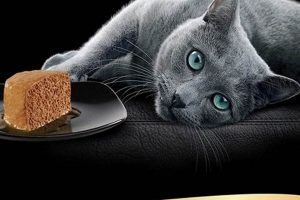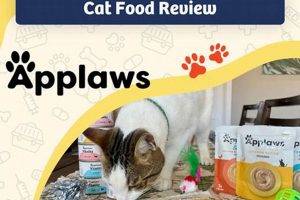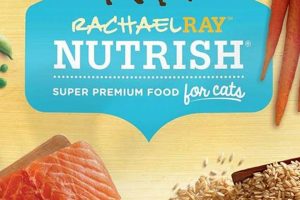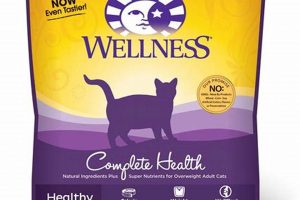Nutrition tailored for felines with an emphasis on cardiovascular well-being is increasingly prevalent within the pet food industry. This specialized dietary option focuses on ingredients and formulations designed to support healthy cardiac function in cats. These products often contain targeted nutrients and controlled levels of certain minerals.
Maintaining optimal cardiovascular health in felines contributes significantly to their overall lifespan and quality of life. Formulations designed to support this aim often incorporate ingredients like taurine, L-carnitine, and omega-3 fatty acids. These components are selected for their established roles in supporting cardiac muscle function, maintaining healthy blood pressure, and mitigating inflammation. The development of these specialized diets reflects a growing awareness of feline-specific health needs and a proactive approach to preventative care.
The subsequent discussion will delve into the specific nutritional components and considerations relevant to the selection and use of cardiac-focused feline diets. Key topics will include ingredient analysis, dietary recommendations for cats with pre-existing heart conditions, and the role of regular veterinary check-ups in maintaining feline cardiovascular health.
Dietary Considerations for Feline Cardiac Wellness
The selection of appropriate nourishment is paramount to supporting feline cardiac health. The following guidelines outline crucial considerations for pet owners seeking to promote cardiovascular well-being in their feline companions.
Tip 1: Consult a Veterinarian. Prior to implementing any significant dietary changes, a thorough veterinary examination is essential. A veterinarian can assess the cat’s current health status, identify any pre-existing conditions, and provide tailored recommendations for dietary management.
Tip 2: Prioritize Taurine Content. Taurine is an essential amino acid for cats, playing a vital role in cardiac muscle function. Ensure the selected dietary product contains adequate levels of taurine, as deficiency can lead to serious heart complications.
Tip 3: Monitor Sodium Intake. Excessive sodium intake can contribute to fluid retention and increased blood pressure, potentially exacerbating cardiac issues. Opt for formulations with controlled sodium levels to mitigate these risks.
Tip 4: Consider Omega-3 Fatty Acids. Omega-3 fatty acids, particularly EPA and DHA, possess anti-inflammatory properties and may support cardiovascular health. Look for diets enriched with fish oil or other sources of omega-3s.
Tip 5: Evaluate Protein Sources. High-quality protein sources are crucial for maintaining overall health and supporting cardiac muscle function. Ensure the primary protein source is easily digestible and provides a complete amino acid profile.
Tip 6: Control Phosphorus Levels. In cats with kidney issues, phosphorus levels should be carefully monitored. Elevated phosphorus can place additional strain on the kidneys, indirectly affecting cardiac function. Select formulations appropriate for cats with kidney concerns, if applicable.
Tip 7: Maintain a Healthy Weight. Obesity can contribute to various health problems, including cardiovascular issues. Ensure the cat’s caloric intake is appropriate to maintain a healthy weight range, as determined by a veterinarian.
These guidelines emphasize the importance of informed decision-making when selecting feline diets. Addressing these nutritional aspects can significantly impact the cardiovascular well-being of feline companions.
The subsequent section will address specific scenarios and frequently asked questions regarding feline cardiac health and dietary management.
1. Taurine Supplementation
Taurine supplementation is a critical consideration in the formulation of feline diets intended to support cardiovascular health. Due to cats’ limited ability to synthesize this essential amino acid, dietary provision is necessary to prevent deficiency and associated cardiac complications.
- Preventing Dilated Cardiomyopathy (DCM)
Taurine deficiency is a known cause of dilated cardiomyopathy (DCM) in cats, a condition characterized by enlargement and weakening of the heart muscle. Supplementation ensures adequate taurine levels to maintain proper cardiac muscle function and prevent the development of DCM. The absence of sufficient taurine disrupts calcium homeostasis within cardiac cells, leading to contractile dysfunction.
- Supporting Cardiac Muscle Contraction
Taurine plays a vital role in regulating intracellular calcium concentrations within cardiac myocytes. Calcium is essential for the excitation-contraction coupling process, which dictates the force and efficiency of cardiac muscle contraction. Adequate taurine levels support optimal calcium handling, thereby contributing to healthy heart function.
- Maintaining Membrane Stability
Taurine is involved in stabilizing cell membranes, including those of cardiac cells. This membrane stabilization helps protect cardiac cells from oxidative stress and damage. Cellular damage can impair cardiac function, and taurine’s protective role can contribute to long-term cardiovascular health.
- Regulating Osmotic Balance
Taurine contributes to osmotic balance within cells, influencing cell volume and fluid regulation. Proper osmotic balance is important for maintaining the structural integrity and functionality of cardiac cells. Disruptions can lead to cellular swelling or shrinkage, impairing cardiac function.
These facets underscore the significance of taurine supplementation in maintaining feline cardiovascular health. Diets lacking sufficient taurine can lead to serious cardiac complications, highlighting the importance of selecting nutritionally complete and balanced foods specifically formulated to address feline physiological needs. This supplementation is a cornerstone of dietary strategies aimed at promoting “strong heart cat food” and overall well-being.
2. Sodium Level Control
Sodium level control is a critical aspect of dietary management for feline cardiovascular health. Excessive sodium intake can contribute to detrimental physiological effects, particularly in cats predisposed to or already exhibiting cardiac dysfunction. Therefore, careful consideration of sodium levels in feline diets is essential.
- Managing Blood Pressure
Elevated sodium intake contributes to increased blood volume, leading to a corresponding rise in blood pressure. In cats with existing cardiac conditions such as hypertrophic cardiomyopathy, elevated blood pressure can exacerbate cardiac workload and contribute to further myocardial damage. Sodium restriction aids in maintaining optimal blood pressure levels, reducing strain on the heart.
- Reducing Fluid Retention
Sodium promotes water retention within the body. Excessive sodium intake can lead to fluid overload, potentially resulting in pulmonary edema or ascites, conditions that compromise cardiac function and respiratory efficiency. Controlled sodium levels minimize fluid retention, mitigating the risk of these complications.
- Supporting Renal Function
While direct cardiac effects are paramount, appropriate sodium levels also support renal function. The kidneys play a crucial role in regulating fluid and electrolyte balance, and excessive sodium excretion can place undue stress on these organs. By managing sodium intake, the dietary approach helps to support both cardiovascular and renal health concurrently.
- Minimizing Exacerbation of Heart Failure
Heart failure is a progressive condition characterized by the heart’s inability to adequately pump blood to meet the body’s needs. High sodium intake can exacerbate the symptoms of heart failure, leading to increased shortness of breath, fatigue, and overall decline in quality of life. Sodium level control aims to alleviate these symptoms and improve cardiac efficiency.
These considerations emphasize the significance of sodium level control as a central component of a dietary strategy designed to promote “strong heart cat food.” By carefully managing sodium intake, veterinary professionals and pet owners can proactively support feline cardiovascular well-being, minimizing the risks associated with excessive sodium consumption.
3. Omega-3 Fatty Acids
Omega-3 fatty acids, particularly eicosapentaenoic acid (EPA) and docosahexaenoic acid (DHA), are recognized for their potential benefits in supporting cardiovascular health. Their incorporation into feline diets aimed at promoting cardiac well-being reflects a growing understanding of their physiological effects.
- Reducing Inflammation
Omega-3 fatty acids exhibit anti-inflammatory properties. Chronic inflammation is implicated in various cardiovascular diseases. EPA and DHA can modulate the production of inflammatory mediators, thereby potentially mitigating inflammatory processes within the heart and vasculature. This reduction in inflammation may contribute to improved cardiac function and reduced risk of related complications.
- Supporting Endothelial Function
The endothelium, the inner lining of blood vessels, plays a critical role in regulating vascular tone and preventing clot formation. Omega-3 fatty acids can enhance endothelial function by promoting the production of nitric oxide, a vasodilator. Improved endothelial function contributes to healthy blood flow and reduces the risk of thrombosis, both of which are important for maintaining cardiovascular integrity.
- Managing Arrhythmias
Cardiac arrhythmias, or irregular heartbeats, can compromise cardiac efficiency and increase the risk of sudden cardiac death. Omega-3 fatty acids have been shown to possess anti-arrhythmic properties, potentially stabilizing cardiac electrical activity and reducing the likelihood of arrhythmias. This protective effect may be particularly relevant in cats with pre-existing heart conditions.
- Lowering Triglyceride Levels
Elevated triglyceride levels in the blood are associated with increased risk of cardiovascular disease. Omega-3 fatty acids can lower triglyceride levels, contributing to improved lipid profiles. This reduction in triglycerides may help prevent the accumulation of plaque within arteries and reduce the risk of atherosclerosis.
These multifaceted effects of omega-3 fatty acids underscore their relevance to the formulation of diets intended to support cardiac health in felines. Their potential to reduce inflammation, support endothelial function, manage arrhythmias, and lower triglyceride levels contributes to a comprehensive approach to maintaining cardiovascular well-being. The inclusion of omega-3 fatty acids in “strong heart cat food” reflects a commitment to leveraging nutritional strategies to promote optimal cardiac function.
4. Protein Source Quality
The quality of protein sources in feline diets formulated for cardiovascular health is of paramount importance. Protein provides the essential amino acids necessary for the synthesis and maintenance of cardiac muscle tissue, as well as for the production of crucial enzymes and hormones involved in cardiovascular function. Suboptimal protein sources can lead to deficiencies, impairing cardiac performance and overall health. For instance, a diet relying heavily on plant-based proteins, which may be incomplete in certain essential amino acids for cats, could result in taurine deficiency, a known cause of dilated cardiomyopathy.
Diets emphasizing animal-derived proteins, such as poultry, fish, or meat, generally offer a more complete amino acid profile that aligns with feline physiological needs. The digestibility and bioavailability of these proteins are also critical considerations. Highly digestible protein sources reduce the metabolic burden on the kidneys and liver, indirectly supporting cardiovascular function by minimizing systemic stress. Furthermore, the inclusion of specific amino acids, such as L-carnitine, which aids in fatty acid metabolism within cardiac cells, can further enhance cardiac function. Conversely, diets with low-quality protein may lead to muscle wasting, including the weakening of the heart muscle itself, thereby negating any potential benefits of other cardioprotective nutrients.
In summary, the selection of high-quality, highly digestible protein sources is indispensable for formulating feline diets that effectively support cardiovascular health. These protein sources provide the building blocks for maintaining cardiac muscle integrity, ensuring proper enzyme function, and minimizing metabolic stress. The conscientious selection of appropriate protein sources is therefore a crucial element in ensuring that the dietary product effectively contributes to “strong heart cat food” and overall feline well-being. Ignoring this factor risks undermining the potential benefits of other cardioprotective nutrients included in the formulation.
5. Phosphorus Management
Phosphorus management is an essential consideration in the formulation of feline diets intended to support cardiovascular health, particularly in the context of “strong heart cat food.” Its importance stems from the intricate relationship between renal function, phosphorus metabolism, and cardiac well-being.
- Mitigating Renal Disease Progression
Chronic kidney disease (CKD) is prevalent in older cats and significantly impacts cardiovascular health. Elevated phosphorus levels exacerbate CKD progression, leading to further renal damage and increased strain on the cardiovascular system. Diets designed to manage phosphorus levels help slow the progression of CKD, thereby indirectly supporting cardiac function. For instance, a cat with pre-existing CKD fed a diet high in phosphorus will likely experience accelerated renal decline and increased risk of cardiac complications compared to a cat fed a phosphorus-restricted diet.
- Reducing Mineralization of Cardiac Tissue
Hyperphosphatemia, or elevated blood phosphorus, can contribute to the mineralization of soft tissues, including cardiac tissue and blood vessels. This mineralization can impair cardiac function, leading to decreased contractility and increased stiffness of blood vessels. Phosphorus restriction helps prevent this mineralization process, maintaining the integrity of cardiac tissues. An example would be a cat with advanced CKD exhibiting calcification of the mitral valve, leading to regurgitation and heart failure, a condition less likely to develop in cats with well-managed phosphorus levels.
- Controlling Secondary Hyperparathyroidism
In response to declining renal function and elevated phosphorus, the parathyroid glands release parathyroid hormone (PTH), leading to secondary hyperparathyroidism. Chronically elevated PTH levels contribute to bone resorption and further exacerbate hyperphosphatemia. By controlling dietary phosphorus, the production of PTH is minimized, reducing the overall burden on the cardiovascular system. An example is a cat with CKD experiencing bone pain and weakness due to secondary hyperparathyroidism, conditions that can indirectly impact cardiac health by reducing activity and contributing to muscle wasting.
- Enhancing the Efficacy of Cardioprotective Medications
Many medications used to manage feline heart disease, such as ACE inhibitors and diuretics, can be more effective when renal function is optimized. By managing phosphorus levels and supporting renal health, the overall efficacy of these medications is enhanced, improving cardiovascular outcomes. For example, a cat with heart failure receiving ACE inhibitors and a phosphorus-restricted diet may experience better control of blood pressure and fluid retention compared to a cat receiving ACE inhibitors alone.
In summary, phosphorus management is an indispensable aspect of formulating diets that truly support feline cardiovascular health, particularly within the framework of “strong heart cat food.” By mitigating renal disease progression, reducing tissue mineralization, controlling secondary hyperparathyroidism, and enhancing the efficacy of cardioprotective medications, careful phosphorus management contributes significantly to improved cardiac function and overall well-being in felines. Neglecting this critical nutritional consideration risks undermining the potential benefits of other cardioprotective nutrients and interventions.
Frequently Asked Questions Regarding Feline Cardiovascular Diets
The following questions address common concerns and misconceptions surrounding dietary strategies to support feline cardiovascular health. The responses are intended to provide informative guidance based on current veterinary understanding.
Question 1: Are cardiovascular-specific diets necessary for all cats?
Cardiovascular-specific diets are not universally required for all felines. They are generally recommended for cats diagnosed with pre-existing heart conditions or those at elevated risk due to breed predispositions or age-related factors. A healthy cat without diagnosed cardiac issues typically benefits from a balanced, high-quality commercial diet formulated for all life stages.
Question 2: Can “strong heart cat food” reverse existing heart damage?
Diets formulated to support cardiovascular health cannot reverse existing structural damage to the heart. However, they can play a crucial role in managing the progression of heart disease, alleviating symptoms, and improving the overall quality of life for affected felines. The primary goal is to slow the deterioration of cardiac function and minimize complications.
Question 3: How quickly should one expect to see results after switching to a cardiac diet?
The time frame for observing noticeable improvements after transitioning to a “strong heart cat food” varies depending on the severity of the cat’s condition and individual response. Some cats may exhibit improvements in energy levels or appetite within a few weeks, while others may require several months to demonstrate significant changes. Regular veterinary monitoring is essential to assess the diet’s efficacy.
Question 4: Are there potential risks associated with feeding a cardiac diet to a healthy cat?
While generally safe, feeding a cardiac diet to a healthy cat may not provide optimal nutrient ratios for their specific needs. Cardiac diets often have controlled levels of certain minerals, such as sodium and phosphorus, which may not be ideal for a cat with normal renal and cardiovascular function. It is advisable to consult with a veterinarian before making significant dietary changes for healthy cats.
Question 5: Can homemade diets effectively address feline cardiac needs?
Formulating a homemade diet that adequately addresses feline cardiac needs is exceptionally challenging and requires extensive nutritional knowledge. Achieving the precise balance of essential amino acids, minerals, and other nutrients is critical to avoid deficiencies or excesses. Consultation with a board-certified veterinary nutritionist is highly recommended for pet owners considering homemade diets for cats with heart conditions. Risks associated with imbalances are significant.
Question 6: What role do regular veterinary check-ups play in conjunction with cardiac diets?
Regular veterinary check-ups are indispensable for monitoring the effectiveness of cardiac diets and adjusting treatment plans as needed. Veterinarians can assess cardiac function through physical examinations, blood tests, and imaging techniques, allowing for early detection of any changes or complications. Consistent veterinary oversight is crucial for optimizing the long-term management of feline heart disease.
The information presented addresses prevalent concerns surrounding dietary support for feline cardiovascular health. These responses highlight the importance of informed decision-making and veterinary guidance in managing feline heart conditions.
The subsequent section will explore emerging research and future directions in the field of feline cardiovascular nutrition.
Conclusion
This exploration of nutrition tailored to support feline cardiovascular health has underscored the multi-faceted approach required to formulate effective diets. Key aspects such as taurine supplementation, sodium level control, omega-3 fatty acid inclusion, protein source quality, and phosphorus management have been identified as critical components. “Strong heart cat food” is not simply a marketing term, but a designation that should represent a scientifically informed and carefully executed dietary strategy aimed at promoting cardiac well-being in felines.
The proactive management of feline cardiovascular health through dietary intervention represents a significant opportunity to improve the quality of life for affected animals. Continued research and refinement of nutritional strategies will be essential to further optimize cardiac support and address the evolving needs of aging feline populations. Veterinarians and pet owners alike must remain vigilant in recognizing the importance of dietary choices and collaborate to ensure the best possible outcomes for feline companions at risk of, or already diagnosed with, heart conditions.







